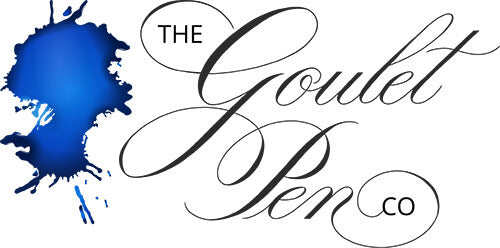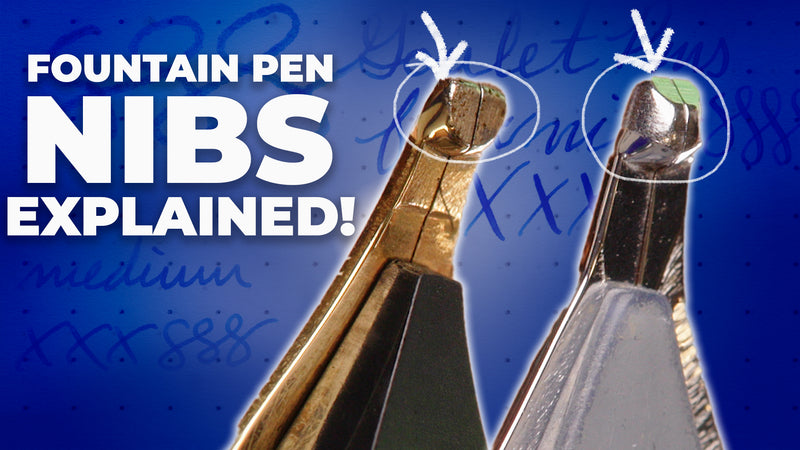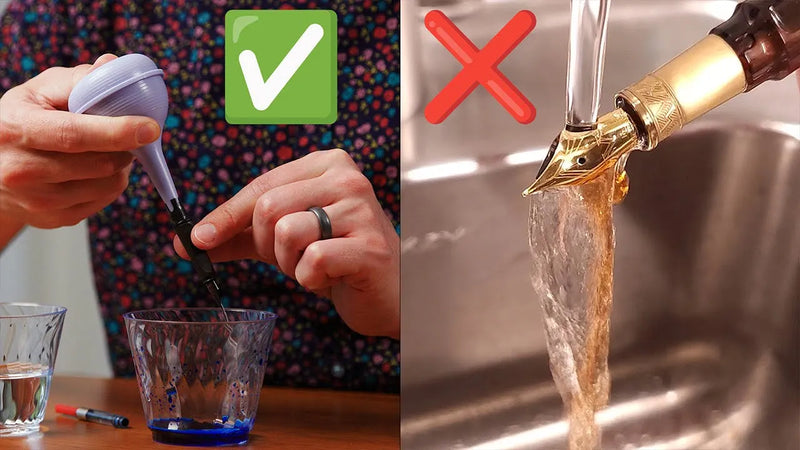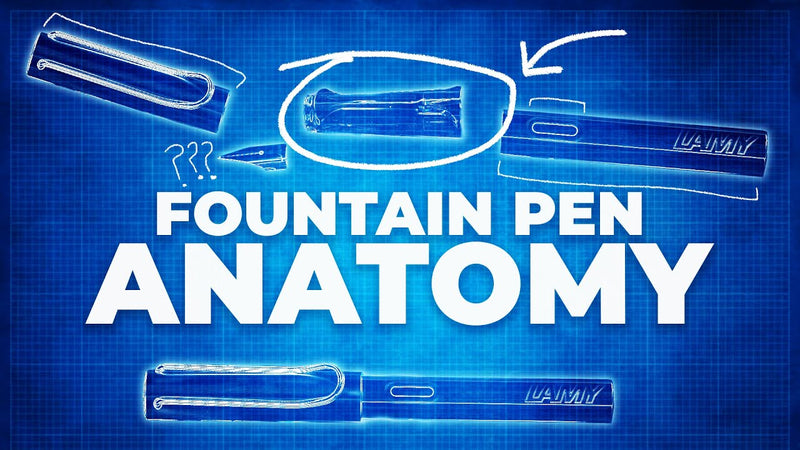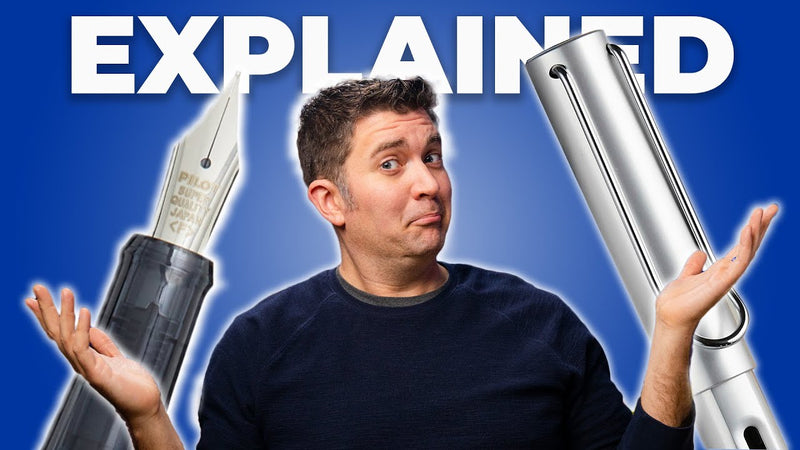How to Write with a Fountain Pen
Fountain Pen 101: Part Five
Welcome to the 5th and final video in our Fountain Pen 101 series! I’ll be going over the best ways to hold a fountain pen, proper writing posture, and explore the trifecta of pen, ink and paper that will help you to get the best writing experience possible. My goal is to lay all the groundwork needed for you to enjoy your fountain pen writing experience to the fullest!
How to Hold a Fountain Pen
When placing a fountain pen in your hand, hold the grip of the pen with your fingers and rest the body of the pen in the crook or web between your thumb and index finger. You don’t want your fingers to touch the nib itself, so grab onto the grip in whatever place feels most comfortable to you above the nib. The nib will be facing up, and the underside with the feed down towards the paper.
Grip
Most people will hold their pens with a 3-fingered grip using the thumb, index, and middle finger. Some people use a 4-fingered grip which for me is impossible as my fingers are too large, but basically you can hold it however you feel comfortable. The idea is that the pen is resting mostly on your middle finger, with your thumb and pointer finger acting like tweezers for making very precise movements.
Holding a fountain pen with a 3-fingered grip
Holding a fountain pen with a 4-fingered grip
You don’t want to feel like you’re having to grip the pen tightly. It should be firmly in place, but with only enough grip strength to control the pen. The harder you grip your pen, the more you’ll fatigue your hand and run into cramping issues as you write. Just relax.
The major benefit of a fountain pen is the ink flows easily, so you may have to actually un-train yourself from firm grips you’ve gotten used to with other types of pens. Fountain pens are often thicker than other types of pens, so it makes it a little easier to grip and control your pen with less effort.
Pen Rotation
It’s important to pay attention to the rotation of the pen, keeping it from rolling too much left or right, or you could run into some ink flow issues. Most newer people to fountain pens don’t even realize they rotate the pen in their hands since it doesn’t matter if you do this with any other style of writing instrument, so make sure to check yourself with that if you’re having flow issues.
Pen Angle
Once you feel like you have a relaxed and comfortable position in your hand, take note of the pen angle in relation to the writing surface. Most nibs are ground in such a way that a 45-55 degree angle works best, though you may find that you write with a lower or higher angle than that.
Just know that if you write in an extreme angle you might have to be more selective about the pens you use, or you could consider getting a custom grind to accommodate such an angle.
Since most fountain pens have a removable cap, many of them can be written with as they are with just the body, or with the pen capped onto the back. It’s completely up to you how you want to do it, but the biggest consideration is how it might add weight to the back of the pen which can tire your hand. With resin pens this isn’t usually an issue, but when you get into other materials like metal, the cap weight can get pretty significant. It's totally up to you.
Writing Posture
While writing posture isn’t something you may have ever thought about, it can make a difference in your comfort and even the appearance of your handwriting. I find it helps to think of a fountain pen as a true "writing instrument", just as you would a musical instrument. When you play a musical instrument, there’s a lot of attention given to posture so you can play that instrument well and not fatigue or overwork certain joints or muscles. It’s the same when writing. If you’re just writing a few words here and there, your posture matters a lot less. But if you’re writing for any significant amount of time such as when journaling or penning a letter to someone, take a few seconds to get your posture right and it’ll make a difference for you.
Sit up straight at a desk or table with a flat surface with your feet flat on the floor. You should sit at a height that allows your arm to hang freely with your forearms parallel to the writing surface. This allows you to have full range of arm motion. The heel of your hand should rest on the surface with just the weight of your forearm resting on it. This way you can maintain control of your pen and easily glide your hand across the page.
The ideal writing movement is using a balance of finger movement, wrist movement, and elbow movement. Your fingers have the most precise control for forming letters, but the muscles and tendons in your hand are smaller so they will tire out if you only rely on those. By incorporating your wrist and forearm, you’ll be able to write longer with less fatigue, though admittedly it will take some practice. Try it out and see if it makes a difference for you... like anything else, practice makes progress. What really matters is that you enjoy the process and feel comfortable while you write.
When writing, you may find it helpful to turn the paper in the the direction of your hand, so the paper's more or less in line with your forearm. You can play around with rotating the paper more or less as it suits you. This is especially the case if you’re writing with a stub or flex nib, as the relationship of the writing line to the pen will change the look of your handwriting, so it’s something you might want to experiment with.
While I won’t get into actual handwriting advice or practice, I highly recommend Master Penman Michael Sull’s book The Art of Cursive Penmanship. It's the best resource I've found for advice on cursive handwriting, with lots of practice sheets included. Just know that most of my advice is based on my experience as an American, writing in block print and Palmer method American cursive, and there will be some changes to make if you’re writing in other languages.

Terminology
It’ll be helpful for you to understand a few key terms often used to describe the fountain pen writing experience.
Feedback or tooth can refer to how smooth a nib feels as you write, but it also can be used to describe the smoothness of the paper you’re writing on. If there’s a lot of feedback, that means it’s less smooth and you feel more resistance as you write.
Bleedthrough happens when your ink absorbs all the way through the paper and onto the other side. This can happen with thinner and more absorbent paper, especially with wetter pens and ink. This is rarely a desirable trait, especially in a notebook when you intend to use both sides of the paper.
Ghosting is not quite as extreme as bleedthrough. The ink hasn’t gone through the back of the paper, but you can still sort of see it. Thicker paper helps to avoid this, as does using lighter colored ink.
Spread or feathering can happen with more absorbent paper. It’s basically the paper acting like a sponge and soaking up the ink and spreading it out. Really absorbent paper will make your writing line thicker, and it also flattens out the color and any special characteristics of the ink like sheen or shimmer.
Dry time refers to how quickly your ink dries to the touch. This may or may not matter much to you unless you’re in particular circumstances like writing in a journal you need to close up, or if you’re writing left-handed and you drag your hand across your writing as you go. Dry time can be minimized by the ink formulation itself, by putting less ink down with your pen and nib choice, and by using paper that’s more absorbent.
Ink resistance is a paper feature that causes the ink to pool up on the surface and dry on top, as opposed to being absorbed into the paper. There’s no measurable standard for this, but generally speaking the smoother and heavier the paper is, the more likely it is to resist ink absorbing into it.
Paper weight or thickness can get pretty confusing. Most notebooks have a measure of paper weight instead of paper thickness. There’s often a lot left unknown about exactly what makes up the paper in our notebooks, but very broadly speaking, heavier weighted paper is more likely to be better suited for fountain pen ink than lighter weight. Most decent paper for fountain pens is measured in grams per square meter or gsm, so look for a number like 80gsm when you're shopping.

The Pen/Ink/Paper Trifecta
Now that you’re comfortable in your writing position and with your pen-in-hand, let’s talk about something I like to call the Fountain Pen Trifecta. There’s a relationship between the fountain pen, the ink that flows through it, and the paper it’s written on that will influence the overall enjoyment of your writing experience. This is both a blessing and a curse, because it means you can fine tune exactly what you want to get out of your writing, but it also means it’s going to take some experimentation to figure out exactly what you like and it’s somewhat of a process of self-discovery.
The biggest factors of a fountain pen that affect the trifecta are the nib size, how smoothly the nib is ground, and how much the ink flows through the pen based on the feed and nib design. You can’t do much about how wet a pen writes as that’s all about the feed design, but the broader the nib size you choose, the more ink it’ll put down and the more saturated that ink will appear. With absorbent paper, the more ink your pen puts down, the more likely it is to feather or bleed through the back. So if you use absorbent paper, try a finer nib. The pen itself has the most substantial impact on writing feel and line width, though ink and paper do interplay with these and influence them to a point.
In terms of ink, there are several factors at play. Obviously, the color of the ink itself has the biggest visual impact. If you’re putting down a lot of ink, it’ll look darker and take a bit longer to dry. Characteristics of ink like shading, shimmer, sheen, and dry time are also heavily influenced by how absorbent the paper is. As a general rule when it comes to ink, the broader the nib size and wetter the pen, the more ink it puts down on the paper. The more ink resistant the paper, the ink sits more on top of the page and it holds a crisper line, shows more vibrance of the ink, and shading, shimmer, and sheen will stand out more. That’s all at the compromise of longer dry time though, so there’s a balance. Sadly, very few inks actually advertise their properties, so things like flow and dry time are pretty much left to subjective feedback in reviews or through your own testing.
Paper is often the most overlooked aspect of the fountain pen experience. In the US, our standard paper is just not great. It’s often absorbent and rough, mostly made for inkjet printers, ballpoints, and rollerballs which all work well enough on this type of paper. Fountain pens work okay on this paper too, but you’ll find that upgrading your paper will make a more substantial difference than you’d expect. Going with a smoother and more ink resistant paper, fountain pens will not only feel better, but the vibrance, shading, and color of the ink will drastically improve.

One helpful tip I’ll give you is that while most of the marketing lingo around paper such as "premium" or "ink resistant" are not standardized and are fairly subjective. One of the somewhat more objective specifications you can use to find decent paper is related to its weight. 80-90gsm weight is usually a decent place to start, or get the equivalent 21-24lb bond laser printer paper.
Bottom line – you can vary your own writing experience quite a bit just by trying out different combinations of pens with a variety of nib sizes, different inks, and different papers. You might find just by mixing and matching different ones you find combinations that you really like. Because writing is such a highly personal experience, there’s no one right way to do it. What you really love may well be different than someone else. What matters most is that your pen feels good to you while you write, the ink looks pleasing to your eye, and you find the experience rewarding.
Summary
I strongly encourage you to revisit the 5 videos from the Fountain Pen 101 series from time to time, as we’ve packed a lot into them and I think you’ll be able to learn more as you rewatch them. My goal in this series has been to try to shorten the learning curve for you so you can quickly learn what you need and jump right to the more rewarding parts of writing with your fountain pen. Thank you so much for watching, and Write On!
Additional Resources:
- Fountain Pen 101 part 1: What is a Fountain Pen?
- Fountain Pen 101 part 2: How Do Fountain Pens Work?
- Fountain Pen 101 part 3: How to Clean a Fountain Pen
- Fountain Pen 101 part 4: Fountain Pen Nibs Explained
- Fountain Pen Glossary of Terminology
